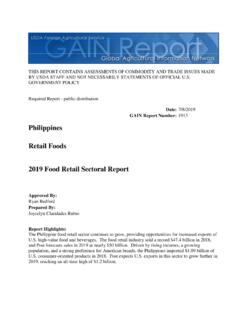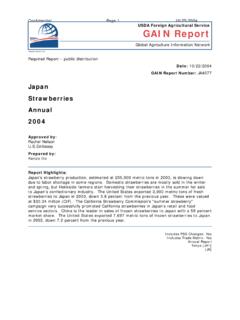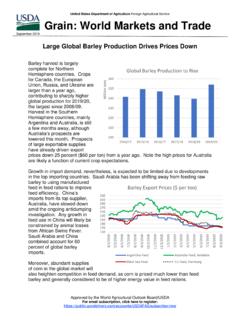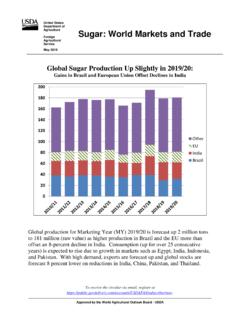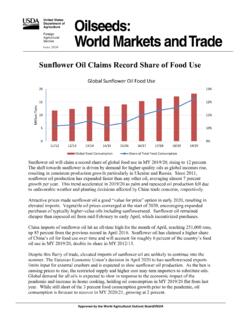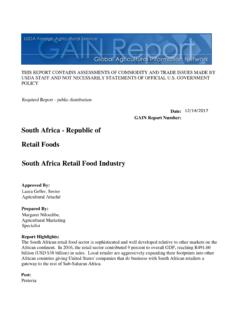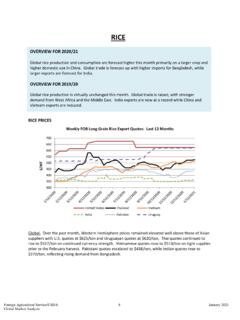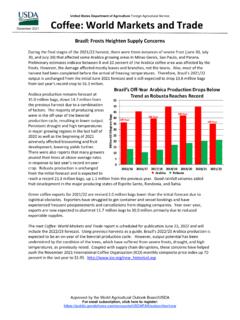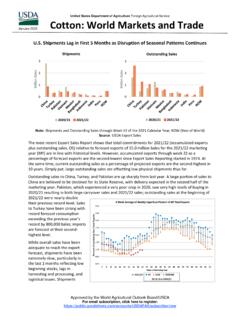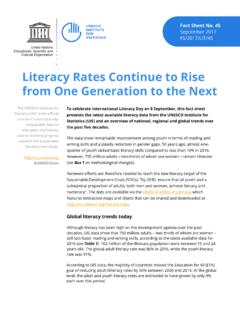Transcription of Dairy Production and Trade Developments
1 United States Department of Agriculture Foreign Agricultural Service July 2019. Although exports of skimmed milk powder (SMP) grew at an annual pace of 7 percent from 2014 through 2018, the Trade challenges facing exporters along with strong competition are expected to lead to a 4 percent drop in shipments for 2019. In contrast, European Union (EU) shipments are booming in the first four months of this year they were up by nearly one third over last year. This led to sharp drawdown of intervention stocks which totaled 175,000 tons at the end 2018 and are now at zero. EU exports of SMP. are expected slow in the second half of the year but for the year are set to increase by 16 percent over 2018. to reach a record 950,000 tons. While Algeria remains a principal destination, the EU is making inroads into such key Asian markets as China and Indonesia which in 2018 were ranked as the second and third largest global import markets for SMP.
2 In the cheese market, prospects for exporters have improved markedly particularly with the recent removal of Mexican retaliatory tariffs. exports of cheese in 2019 are slated to grow by 8 percent over last year. Nevertheless, the EU remains a dominant competitor and its recent free Trade agreements (FTAs) with Mexico and Japan will further intensify competition. In 2018, Japan was third largest export market for cheese and the primary market for cheddar. As the import tariffs for such EU cheeses as cheddar are gradually phased-out (over 16. years) under the FTA, importers will face the challenge of a 30 percent import tariff. This year, Japanese imports of EU cheese in the January-May period are up 18 percent year-over-year (YOY). Approved by the World Agricultural Outlook Board/USDA. Dairy Production and Trade Developments milk Production Summary for Major Exporters (Million Tons). 2018 Dec.
3 2019 Revised 2019 2019 Forecast Forecast Forecast Change Argentina -5%. Australia -8%. EU-28 0%. New Zealand 0%. United States -1%. Major Exporter Total -1%. Note: Data is rounded. Fluid milk : The 2019 milk Production forecast for Argentina is revised down by 5 percent from December's forecast to million tons due to the negative impact of high temperature and humidity levels that prevailed during the early part of this year. These conditions persisted through April and cumulative milk Production was lagging last year's to-date pace by nearly 8 percent. Since May conditions have improved and for the balance of the year, soil moisture levels and normal temperatures are expected to continue ensuring adequate feed supplies. Although high inflation and interest rates persist, milk prices received by farmers in late May were up nearly 60 percent compared to late 2018. Consequently, milk output is expected to revert to normal prior-year levels and Foreign Agricultural Service/USDA 2 July 2019.
4 Office of Global Analysis milk Production for the year is anticipated to be only marginally lower than 2018. milk Production in Australia has been severely impacted by drought which spread to the state of Victoria where some 60 percent of Australian milk is produced. Cumulative milk Production through May 2019. is down 14 percent in comparison to the same period last year despite some recent improvement in rainfall conditions in Victoria. Dairy farmers, however, face the challenge of dealing with poor pasture conditions and low available supplies of feed as they head towards calving in August and peak lactation in October. Consequently, the Dairy cow herd is expected to decline by 50,000 head over 2018 and milk per cow is forecast to fall below 2018. The combination of these effects is likely to have a severe impact on 2019 milk Production ; consequently, the forecast is cut sharply by about 700,000 tons to million tons.
5 This represents a year-over-year drop of 8 percent and would be the fourth consecutive year Australian milk output has declined. Despite the lower milk Production expected for 2019, milk consumption is forecast to be only slightly lower than 2018. This means that less milk will be available for factory use, and it is anticipated that the Production of whole milk powder (WMP), SMP, and butter will decrease while cheese output will remain at similar levels to 2018. A smaller herd and feed shortages following the 2018 drought limited European Union milk Production early in 2019; however, it appears that recent milk output is accelerating as YOY. gains of over 1 percent were recorded in March and April. The rebound in milk Production is particularly evident in Ireland with January through April output up nearly 12 percent over the comparable 2018 period. Other major producing countries such as Poland and the United Kingdom have also posted cumulative gains of nearly 4 percent over the same period.
6 This has been somewhat offset by lower milk output in France down 2 percent and Germany. As a result, the forecast was lowered Foreign Agricultural Service/USDA 3 July 2019. Office of Global Analysis fractionally to 156 million tons and represents a gain of 1 percent over 2018. After a slowdown in EU exports of fluid milk in 2018, the long-term boom in exports of fluid milk appears to be resuming with shipments up by 29. percent in the first four months of this year. China remains the top destination accounting for about one third of the shipments in 2018 and so far, this year . through May for about 45. percent of all fluid milk shipped. That is a 63 percent YOY increase. As a result, the annual forecast for shipments of fluid milk is revised higher by 14 percent to reach 900,000 tons 15 percent over 2018 levels. First half milk output in New Zealand was characterized by extreme volatility as milk Production surged in January and then dropped sharply in March and April to below prior year levels.
7 This was largely due to poor pasture growth in the North Island during the southern hemisphere autumn. By May, conditions had improved and milk Production for the month was only marginally down YOY. However, cumulative milk output was still lagging last year's pace over the same period by 1 percent. For the balance of the year, weather conditions for most areas are expected to follow a normal patterns and milk Production is expected to rebound and match last year's pace. Farmers will also have a greater incentive to buy supplementary feeds as the initial payout for the 2019/2020 (June- May) year is forecast at NZ $ $ milk solids or about 5-10 percent higher than the previous seasonal year. Consequently, despite the slow start, the milk Production forecast is revised up fractionally to million tons which would represent a 1 percent rise above 2018 milk output. Continuing consolidation in China's Dairy sector coupled with high milk prices is expected to provide farmers the incentive to produce more milk .
8 The milk Production forecast for China is revised up 6 percent to million tons; a YOY increase of 2 percent. The modernization of the Dairy industry has shifted Production to larger-scale operations which can more efficiently produce milk . Reportedly the number of Dairy farms with less than 300 head has declined rapidly from around 114,000 in 2011 down to 56,000 farms more recently. In addition, for environmental reasons, Dairy farms near major cities are being closed or being transferred out to other locations. After declining for three years, Dairy cow numbers are expected to rise fractionally in 2019. Foreign Agricultural Service/USDA 4 July 2019. Office of Global Analysis Internal consumption of pasteurized milk and yogurt is driving growth while the consumption of Ultra High Temperature (UHT) milk is slowing. However, UHT milk remains the dominant product as pasteurized milk is estimated to have 14 percent share of the domestic market.
9 Future milk consumption is expected to grow as annual per capita milk consumption is estimated to have grown from 18kg per capita in 2007 to 36 kg per capita in 2018. This is estimated to be only one third of the world average level. CHEESE: The European Union cheese Production forecast for 2019 is raised by 65,000 tons. Although cheese Production is up only percent through April, the growing availability of milk during the remainder of the year is expected to lead to higher cheese Production resulting in annual 1 percent increase over 2018. Most of the additional cheese will go to domestic use which is anticipated to grow by slightly over 1 percent this year. Cheese consumption in the EU has been growing over the past five years at an average rate of nearly 2 percent annually. During the past two years, about 8 percent of total EU cheese output was channeled into export markets and this pattern is likely to be repeated.
10 EU cheese shipments through April are up 3 percent, with strong gains posted to such markets as the United States and Japan, up 7 percent and 18. percent YOY, respectively. However, based on similar export patterns of past years, shipments are likely to slow during the balance of the year. The 2019 cheese export forecast is unchanged reflecting a 1 percent increase over last year. The 2019 cheese Production forecast for New Zealand is cut by 1 percent as it appears that more manufacturing milk is likely to be prioritized towards the Production of WMP. Nevertheless, New Zealand is expected to draw down cheese stocks to support an expansion in cheese exports. As a result, the exports forecast is revised up by 3 percent to 360,000 tons, up 12 percent from the 2018 estimate. Shipments in the first 5 months of this year have been running 7 percent ahead of last year's comparable period with most of the product being shipped to Japan, China, and Australia.
